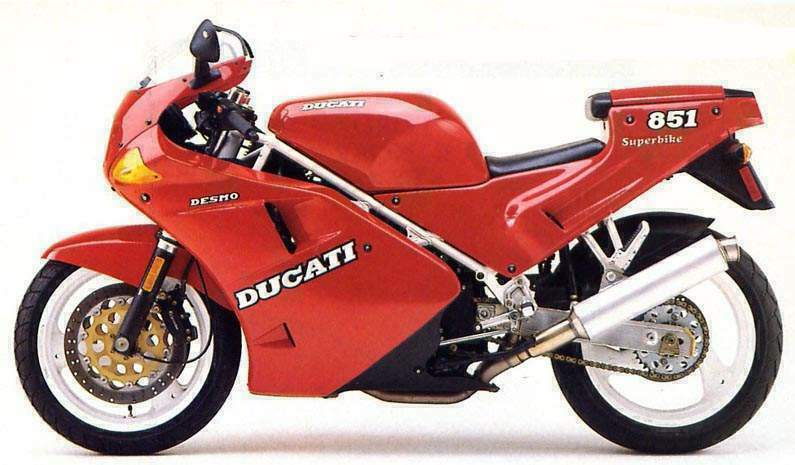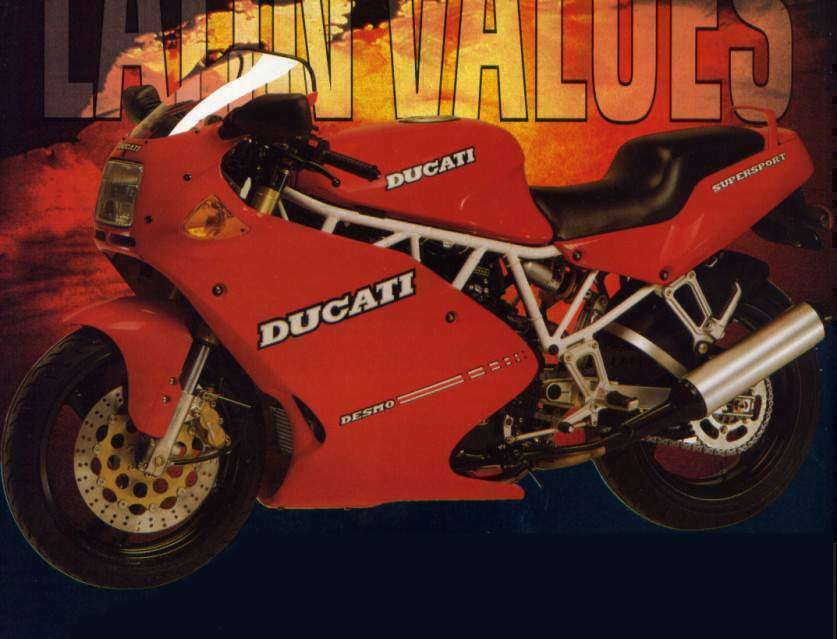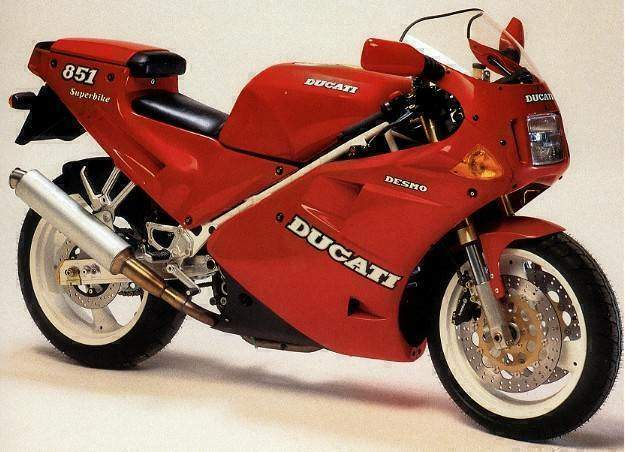
|
|
|
|
|
|
Classic Bikes
Custom Bikes
Individual
Racing Bikes AJP
AJS
Aprilia
Ariel
Avinton / Wakan
Bajaj
Benelli
Beta
Bimota
BMW
Brough Superior
BRP Cam-Am
BSA
Buell / EBR
Bultaco
Cagiva
Campagna
CCM
CF Moto
Combat Motors
Derbi
Deus
Ducati
Excelsior
GASGAS
Ghezzi Brian
Gilera
GIMA
Harley Davidson
Hero
Highland
Honda
Horex
Husaberg
Husqvarna
Hyosung
Indian
Jawa
Kawasaki
KTM
KYMCO
Laverda
Lazareth
Magni
Maico
Mash
Matchless
Mondial
Moto Guzzi
Moto Morini
MV Agusta
MZ / MuZ
NCR
Norton
NSU
Paton
Peugeot
Piaggio
Revival Cycles
Roland Sands
Royal Enfield
Sachs
Sherco
Sunbeam
Suzuki
SWM
SYM
Triumph
TVS
Ural
Velocette
Vespa
Victory
Vincent
VOR
Voxan
Vyrus
Walt Siegl
Walz
Wrenchmonkees
Wunderlich
XTR / Radical
Yamaha
Zero
Video
Technical
Complete Manufacturer List
|
Ducati 851 SP Biposto
|
| . |
|
Make Model |
Ducati 851 SP Biposto |
|
Year |
1990 - 92 |
|
Engine |
Four stroke, 90°“L”twin cylinder, DOHC, desmodromic 4 valves per cylinder, belt driven |
|
Capacity |
851 cc / 51.9 cu in |
| Bore x Stroke | 92 x 64 mm |
| Compression Ratio | 10.5:1 |
| Cooling System | Liquid cooled |
|
Induction |
Weber I.A.W. CPU P7 electronic fuel injection. 2 x 50mm throttle bodies |
|
Spark Plugs |
Champion A59GC |
|
Ignition |
Inductive magnetically triggered |
|
Battery |
12V 16Ah |
|
Starting |
Electric |
|
Max Power |
80.9 kW / 110 hp @ 9600 rpm (rear tyre: 69.9 kW / 95 hp @ 9000 rpm) |
|
Max Torque |
70.6 Nm / 7.2 kgf-m / 52.1ft-lb @ 7000 rpm |
|
Clutch |
Dry,multiplate |
|
Transmission |
6 Speed |
|
Primary Drive Ratio |
2:1 (31/62) |
| Gear Ratios | 1st 2.466 / 2nd 1.765 / 3rd 1.400 / 4th 1.182 / 5th 1.043 / 6th 0.958:1 |
|
Final Drive Ratio |
2.6:1 (15/39) |
|
Final Drive |
Chain |
|
Frame |
Tubular steel |
|
Front Suspension |
41 mm Showa upside-down fork with rebound compression damping adjustable |
|
Rear Suspension |
Showa single shock with preload and damping adjust |
|
Front Brakes |
2 x 320 mm Disc, 4 piston calipers |
|
Rear Brakes |
Single 245 mm disc, 2 piston caliper |
|
Front Tyre |
120/60 x 17 |
|
Rear Tyre |
180/55 x 17 |
|
Rake |
24o |
|
Trail |
94 mm / 3.7 in |
|
Dimensions |
Length: 2000 mm / 78.7 in Width: 670 mm / 26.4 in Height: 1120 mm / 44.1 in |
|
Wheelbase |
1430 mm / 56.3 in |
|
Seat Height |
760 mm / 29.9 in |
|
Dry Weight |
199 kg / 439 lbs |
|
Wet Weight |
210kg / 462 lbs |
|
Fuel Capacity |
20 Litres / 5.3 US gal / 4.4 Imp gal |
|
Consumption Average |
5.1 l/100 km / 19.8 km/l / 46.6 US mpg / 55.9Imp mpg |
| Colours | White frame, red |
| Road Test | Moto Sprint 1990 |
| . |
SCEPTICISM. THAT'S WHAT'S needed to test the latest Ducati 851. And lots of it. Bollocks to all that legendary-Italian-oozing-character-from-every-pore tosh. The question is: is it any good?
Because if it isn't up to the standards ofjapanese sports bikes costing three grand less, then it deserves to get slagged, and no amount of 'character' is going to save it.
Damn. It's really rather good; besides looking even more yummy in the flesh than in photos, the 851 Strada actually goes. Only slightly fiddled with since last year it was hardly going to be a complete waste of space, but it could have been average — the Strada is, after all, merely the low-spec version of the 851 SPs, which are low-spec versions of the racey 888s.
Average it is not. The engine feels like a Super Tenere motor with a ripper of a powerband stuck on. Ducati has improved midrange power over the '91 Strada by increasing valve diameters (inlets are now 33mm, exhausts 29mm — the same as the SP), and adjusting the Weber engine management system, but it's still not brilliant. Maybe I believed too much of the gush Ducati fans come out with, but below 7000rpm the Strada didn't haul ass as I'd expected. It's not weedy, but there's not enough to stop you looking for amusement further up the rev-range.
All the action (aural and otherwise) is above 7000rpm; it's the first four-stroke twin I've ridden with a powerband. The engine management system changes give an extra five bhp at the top-end over last year's machine, and between seven and the redline at 10,000rpm is a surge of power well worth chasing up and down the surprisingly good gearbox (not Suzuki slick, but not far off). Ducati now claims a maximum power output of 95bhp at 9000rpm which isn't that special considering most decent sport 600s do better, but the Italians point out that this is power at the back wheel; at the crank the Strada gives 110bhp.

It feels much more though. With the go-faster noise from the twin pipes, the heavyweight rumble coming through pegs, bars and saddle, and power coming in with a wallop, you blast off up the road no faster than a screaming ZXR750, but it feels like Superbike hero Rob Phillis would struggle to keep up.
Whereas minor engine improvements are numerous — engine management sensor repositioning, waterpipe re-routing etc - the frame gets just one change: the rider's foot-pegs are now mounted on bendablc hangers, rather than direct onto the frame. Owners of '91 Stradas were finding that an embarrassing low speed drop would, through the foot-pegs, bend the frame as well. Now it will just bend a hanger.
Frantic squeeze
Apart from that, the '92 Strada frame is identical to last year's. Parked between a couple of ZXRs with bulging beams, it's difficult to see how Italian art can compete with Japanese heavy engineering. But it does. With 41mm Showa forks at a rake angle of 24 degrees, and the swing-arm controlled via a pleasingly understandable cantilever system, the chassis feels stiff, controlled and instantly inspires confidence on bumpy dual carriageway sweepers.
High speed corners are where the 851 excels. Blasting round slow ones is possible, but only after practice. The first problem is psychological: compared to your FZGSZXR, the
Strada is tall (seat height: 31in), so tipping it in has you dropping like a stone for what seems like ages - it feels there is no way a handful of throttle can get you through. Result: you wimp out, pick it up and go round gently.

The second problem is that despite its steep rake and 94mm of trail, the Strada is stiff, almost unwieldy, in slow turns. It just doesn't feel happy being flopped into an unknown bend, coasting round on a neutral throttle until you can see the exit, then blasting out. Because the Showa forks and firm rear shock behave impeccably, the 851 never feels unsure, just top heavy.
On faster bends scepticism flies straight out the window. Approaching corners off the brakes, you yank the bars to tip it in (the steering feels fast enough here), and almost immediately pile on the power: it is manoeuvrable, yet solid as a ZXR750, but with none of the worry that a mid-corner bump will fire you out of the saddle. Awww-weeesssooommme.
Unfortunately the brakes don't last. At first the Brembo Gold Line calipers and twin 320mm discs feel strong, but without the initial bite of, say, an EXUP - despite Ducati increasing master cylinder diameter from 15 to 16mm. But what they lose in brick wall stopping power the Brembos make up for with enough feedback to get the back wheel skipping with no inkling of worry. 'Feel', I think it's called, and within an hour of hard use, it's on the wane. All four fingers end up frantically squeezing the lever into the bar. For £10,400 (£10,575 on the road) you'd think Ducati would sort the brakes - some steel hose and a different pad compound would probably do the trick.
As usual Michelin's Hi-Sports are faultlessly sticky. Can't see them lasting more than 2000 miles though.

The snatchy dry clutch causes a few stalls at first, but seems quite-happy being slipped left, right and centre battling with the miniscule steering lock (which can be adjusted slightly, but not much because the bars soon hit the new, slimmer tank), and the engine shows no signs of being an overheater — even during hot waits in traffic queues this year's bigger curved radiator keeps the temperature gauge needle away from the red zone.
But before ye of little faith in Italian reliability start eating your words... after three hours the battery went flat. If it was raining then the failure is understandable because half the battery pokes out from under the tank and is exposed to the elements. But it was sunny (I could tell because the idiot lights were invisible). Thankfully fuel injection makes solo bump-starts, both hot and cold, a doddle, but you have to get up a fair old lick to overcome the 10.5:1 compression.
So there you have it: the Strada is as good as, perhaps better than, most £7000 Japanese racer-replica 750s, but is different and pretty enough to warrant people going bananas over its 'character' (and paying three grand more). Ducati fans will swoon over the irritating quirks, but these are getting fewer with every model: beware - a 'normal' Ducati could only be a couple of years away. □
Source Bike Magazine 1992
|
Any corrections or more information on these motorcycles will be kindly appreciated. |